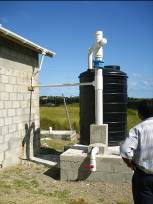





 Water is our most vital natural resource, supporting life and life support processes. While there is as much as 1,400 million km3 of water on earth, only one-hundredth of 1% of this amount is easily available for human use. The amount of water available for each person will continue to decrease as the world's population expands. Unfortunately our present and future water supplies in many parts of the world are being degraded by pollution from domestic waste water, solid waste, industrial effluent and agricultural drainage to name a few. As our natural waters become more polluted, less water is available for our needs and the needs of the natural environment. Every year, approximately 25 million people die, by either drinking polluted water or because they do not have enough water to meet their daily needs.
Water is our most vital natural resource, supporting life and life support processes. While there is as much as 1,400 million km3 of water on earth, only one-hundredth of 1% of this amount is easily available for human use. The amount of water available for each person will continue to decrease as the world's population expands. Unfortunately our present and future water supplies in many parts of the world are being degraded by pollution from domestic waste water, solid waste, industrial effluent and agricultural drainage to name a few. As our natural waters become more polluted, less water is available for our needs and the needs of the natural environment. Every year, approximately 25 million people die, by either drinking polluted water or because they do not have enough water to meet their daily needs.
A single person needs at least half a litre (0.11 gallons) per day to meet basic survival needs and two litres (0.44 gallons) per day to avoid thirst. Some 27 to 200 litres (6 to 44 gallons) are needed per person per day for drinking, sanitation, bathing and cooking. Household water needs vary depending on the type of dwelling, number of residents and type of plumbing fixtures.
 Household rainwater harvesting (RWH) systems can be very simple as the water is collected and used at the same point, thus reducing the need for lengthy channeling and transmitting infrastructure. This is particularly useful in areas with dispersed housing patterns, where it may not be cost effective to lay pipeline to remote scattered houses. Generally, rooftops serve as catchments for household systems and rainwater is conveyed via roof guttering to the storage unit (usually a tank made out of plastic, concrete or metal). Communal systems require larger catchments e.g. pavements and an extensive conveyance system. Whether simple or complex, it is important that the catchment, conveyance and storage devices are made of inert materials to avoid water contamination. Inert materials include galvanized roofing sheets and PVC gutters. RWH systems usually include a first flush system, which shunts the first set of collected rainwater away from the storage unit, taking away contaminants like dust, debris and organic material which may have accumulated on the catchment between rain showers. Water contamination can also be reduced by using various filtration systems e.g. a fine mesh or a sand and charcoal filter system. For drinking water, UV disinfection and/or chlorination may be needed to reduce microbial threats. RWH systems require some maintenance and care, as tanks, gutters, pipes and catchment areas need periodic inspection and cleaning to minimize water contamination and ensure maximum collection volume.READ MORE...
Household rainwater harvesting (RWH) systems can be very simple as the water is collected and used at the same point, thus reducing the need for lengthy channeling and transmitting infrastructure. This is particularly useful in areas with dispersed housing patterns, where it may not be cost effective to lay pipeline to remote scattered houses. Generally, rooftops serve as catchments for household systems and rainwater is conveyed via roof guttering to the storage unit (usually a tank made out of plastic, concrete or metal). Communal systems require larger catchments e.g. pavements and an extensive conveyance system. Whether simple or complex, it is important that the catchment, conveyance and storage devices are made of inert materials to avoid water contamination. Inert materials include galvanized roofing sheets and PVC gutters. RWH systems usually include a first flush system, which shunts the first set of collected rainwater away from the storage unit, taking away contaminants like dust, debris and organic material which may have accumulated on the catchment between rain showers. Water contamination can also be reduced by using various filtration systems e.g. a fine mesh or a sand and charcoal filter system. For drinking water, UV disinfection and/or chlorination may be needed to reduce microbial threats. RWH systems require some maintenance and care, as tanks, gutters, pipes and catchment areas need periodic inspection and cleaning to minimize water contamination and ensure maximum collection volume.READ MORE...